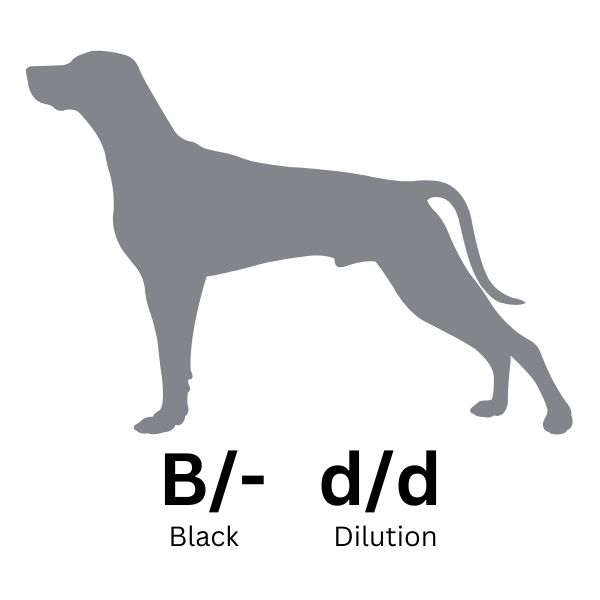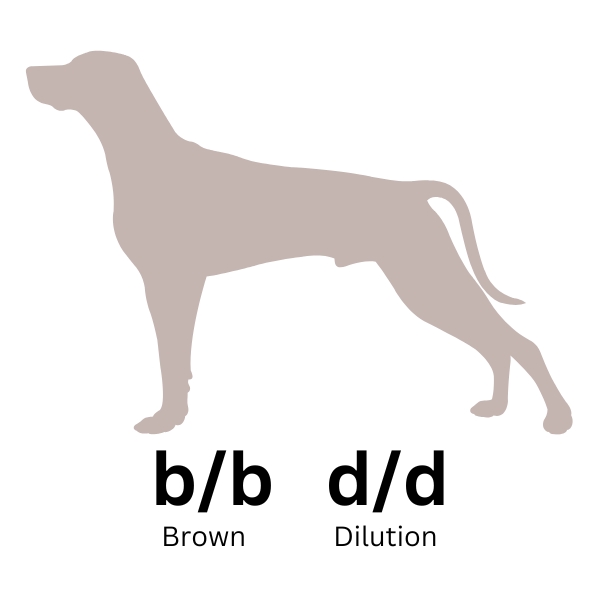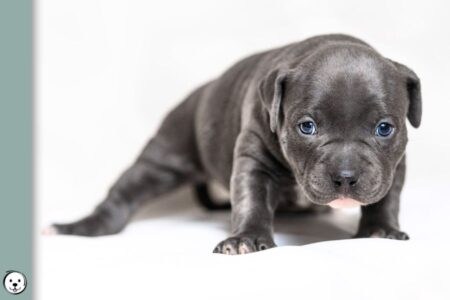A blue Weimaraner has a solid dark gray or blue coat with diluted black pigment. However, blue it is not a standard coat color for Weimaraners and is not recognized by the AKC or FCI.
Gallery
Here are some examples of blue Weimaraners:



Description
Blue Weimaraner dogs have a solid charcoal gray coat color.
If you compare blue and silver-gray Weimaraners, you will notice that blue dogs are much darker.
This is because they are genetically black dogs with color dilution, compared to the standard mouse-gray or silver-gray coat seen on brown dogs with color dilution.


The darker pigment on blue Weimaraners is not only visible in their coat, but also in their lips, eye rims, skin pigment and paw pads. They also have a slate gray nose that sets them apart from silver dogs.
Their eye colors range from greenish-yellow to amber or hazel. Puppy eyes in blue-gray Weimaraners can be exceptionally pale and look anything from sky blue to pale green.
In the FCI, Weimaraners come with short or long coat. Some US breeders might also produce long-haired blue Weimaraners (since with this color, it is not a recognized variety anyway).
Breed Standard
A dark blue Weimaraner differs from the silvery mouse-gray coat seen on more typical silver specimens by having diluted black instead of diluted brown pigment.
According to the American Kennel Club, blue is not a standard color in Weimaraners. In the US, blue dogs can be registered with the AKC but are disqualified from conformation events.
[…] solid color, in shades of mouse-gray to silver-gray, usually blending to lighter shades on the head and ears […] A distinctly blue or black coat is a disqualification.
The FCI standard feels the same way. Blue Weimaraners can not enter show or hunting events.
Silver, roe or mouse grey, as well as shades of these colours. […]
Disqualifying Faults: […] Colour other than grey. Blue colouring.
Blue Weimaraner Genetics
In genetic terms, Weimaraners have a solid color pattern from being dominant black (KB/KB).
However, their coat is obviously not black. And that is because all Weimaraners are also fixed for color dilution (d/d) which clumps their pigment granules and thereby lightens their eumelanin.
A silver Weimaraner is brown (b/b) with color dilution (d/d).
But a blue Weimaraner is black (B/B or B/b) with color dilution (d/d).


Black is dominant to brown. And this makes blue dominant to silver. To produce a blue Weimaraner, at least one parent has to be blue to have a B allele he can pass on.
See the B-Locus and D-Locus posts for more details.
Since B is the dominant trait at the B locus, all Weims having at least one B allele will express blue pigment (black turned to blue by color dilution).
In other words, all blue Weimaraners have to have at least one visibly blue parent (B/-).
Litters from two silver Weimaraners (b/b x b/b) can never produce blue because neither parent has a dominant B to pass on. Only blue Weimaraners can produce more blue Weimaraners.
Where does blue in Weimaraners come from?
Blue Weimaraners are known to have occurred in some hunting lines and even in the foundation stock of US Weimaraners. For example, look at Cäsar von Gaiberg.
In the past, where color was not all that mattered and color definitions were kind of vague, some lighter blue dogs may have passed as dark silvers and been used for breeding. But this is unlikely because breeders should easily be able to spot blue puppies next to their silver-colored siblings.
It is not possible to trace back how long blue was present in the breed before it was declared undesirable. It is likely that the B allele entered the breed by crossbreeding with black pointing dog breeds such as German Shorthaired Pointers (or rather their ancestors). Until 1922, Weimaraners were entered in the German Pointer stud book and many breeders of the time considered Weims as a mere GSP variety.
Learn More

Hi! I’m Steffi. I am a biologist and a big time dog nerd. You are curious about coat color genetics? You’ve come to the right place! Read more.







